 The Canadarm
The Canadarm





- The human component
- The Manufacturing Component
- The Structure
- Stabilization and Attitude Control
- Energy Collection and Storage
- The Canada Arm
There are two key parts of the manufacturing facility and
The human component of the manufacturing facility has two major requirements.
The design of the human facility is essentially a stripped down version of the Mir Core module.
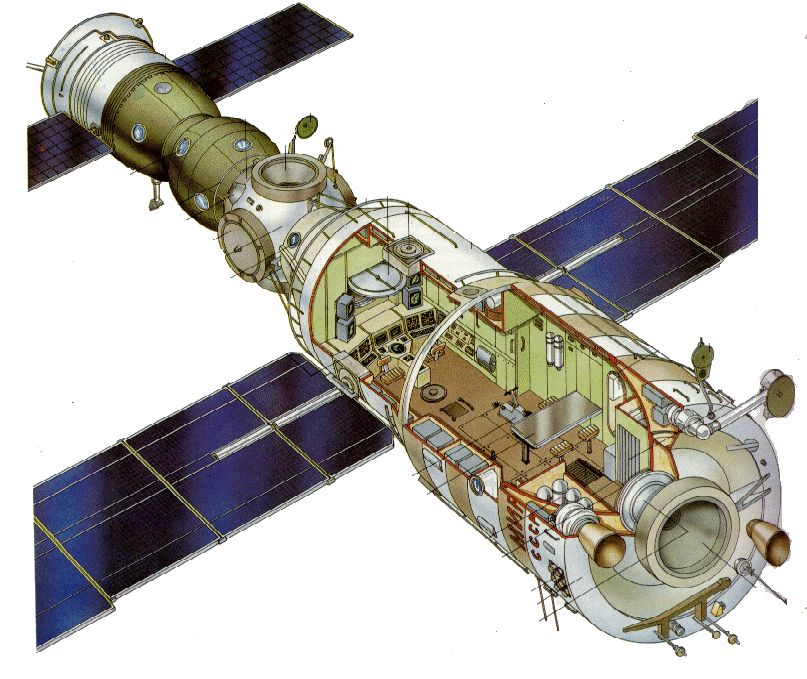
The major cost in making the module to hold the living quarters and the control of the manufacturing facility lies in the design of the module. The design of the Mir core module could easily be altered to suit our needs, and copying this design and having it built by the same company which built the Mir core module would save us millions of dollars. Below is a rough draft of the floorplan that our module would need.
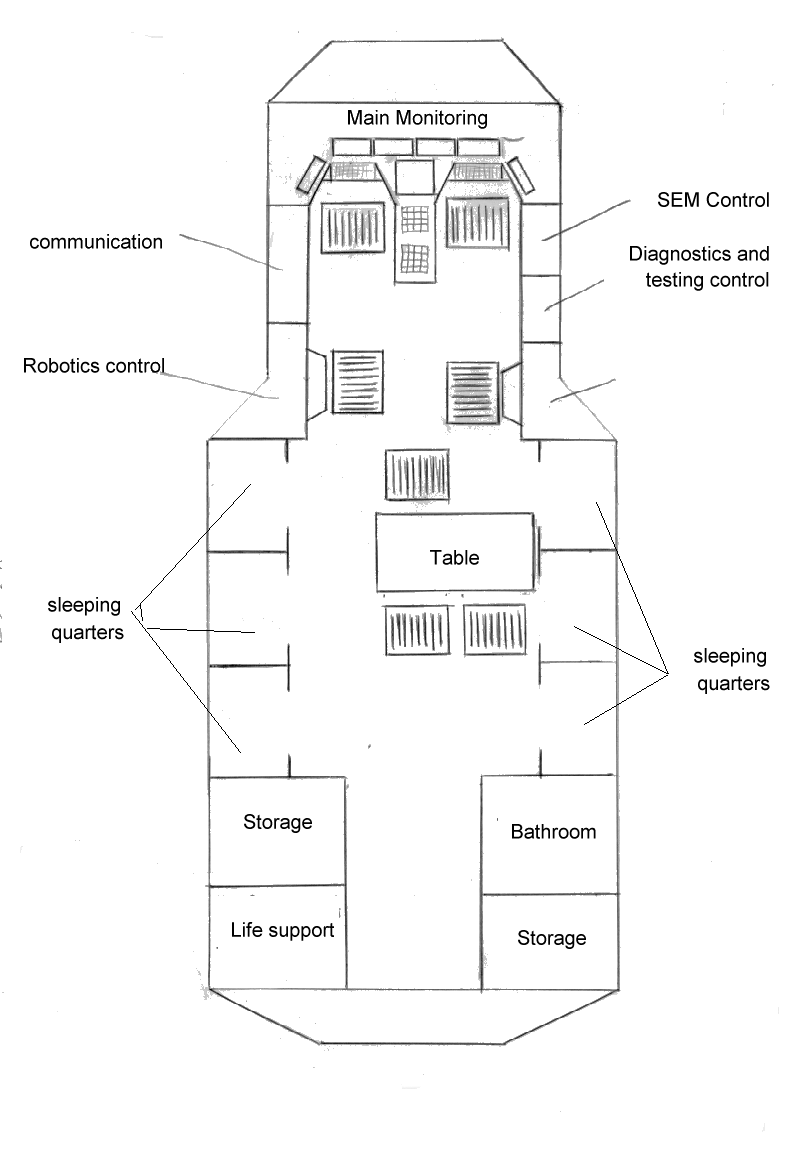
Although this drawing looks quite roomy, it is far from it.The lower half of the floorplan contains the living quarters, storage, and necessary life support equipment. This section of the module is fairly straight forward and doesn't really require much explanation.
The upper half of the floorplan contains all of the controls for the manufacturing facility. On the left hand side, there is a section for communications, mainly with the utilities module on the facility, but also somewhat for communications with Earth. Below that is the override control of the robotics. This section would allow for one of the crew to take control of any of the robots on the facility, should anything go wrong, or should a test need to be made. On the right hand side of the floorplan, there is a section for control of the scanning electron microscope (SEM) which is located on the manufacturing facility, and below that is a control section for the other diagnostic and electrical testing of the chips, which would by done remotely from the human module. Below this testing section, there is a control of the Canadarm on the facility, which can only be controlled manually. This would only be used when loading and unloading supplies/products to and from the shuttle, and in moving equipment to the EVA airlock onboard the facility to be repaired.
The front of the human module would contain all of the monitoring and control of the actual manufacturing process and power systems. The main monitoring consists of six monitors (which can be seen in the drawing), two of which are computer terminals and the other four of which are viewing screens which can toggle between the cameras on any given piece of machinery or other system in the facility. Above these monitors (which is not shown in this drawing) would be four main monitors, one for each corner of the facility, which cannot be changed, and which allow for constant observation of the facility as a whole. In between the seats resides the power control system, with a computer monitor which shows power input, usage, etc., and controls to adjust the solar panels, flywheels, and power supply to each piece of machinery.
The manufacturing facility will be very highly controlled through robotics and other electronics, all of which will allow minimal human contact with the chips, thus reducing the possibility of contamination. Although, this is perfectly fine, we do not want to have the facility being automated to a high degree, as this almost always leads to problems. Therefore, we will need a steady cycle of people monitoring and controlling the facility. A crew of six people is needed, working in pairs, with each pair working an 8 hour shift. With 3 shifts per day this will allow the facility to run 24 hours a day and maximize efficiency. A pair of workers will have a work period of about 6 months, and will be brought up/down with the space shuttle.
The manufacturing component of the station will be independent from the human component with the exception of a tether that will run between them. This tether will include a cable for mooring, fiberoptics for high speed control and monitoring of the equipment on the station, and power cables.
The structure of the manufacturing facility is made with a type of cross hatch triangular bar made of an aluminum alloy. This is structurally sound, very light weight, and easy to ship and deploy.
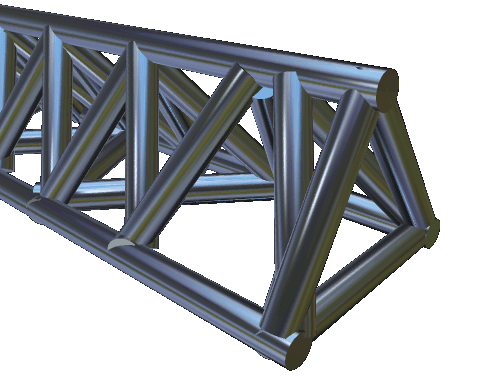
The station is designed around the rectangle. This shape was chosen to allow easier building and movement of automated machinery. It is also a very familiar shape to construct. The approximate dimensions of the rectangle is 10x20 meters
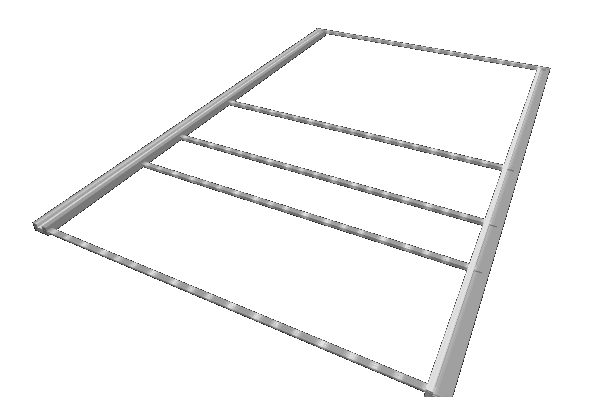
To maintain control of the stations movements there are two key systems installed on the structure. 1) thrusters 2) gyroscopic stabilization.
There are four banks of thrusters on the station- one on every corner of the rectangular platform. These thrusters can assist in preventing unwanted rotations of the station and push the station into a higher orbit when necessary. Thrusters have one drawback in that, if attitude control is maintained with only thrusters, a great deal of fuel will be expended on a regular basis.
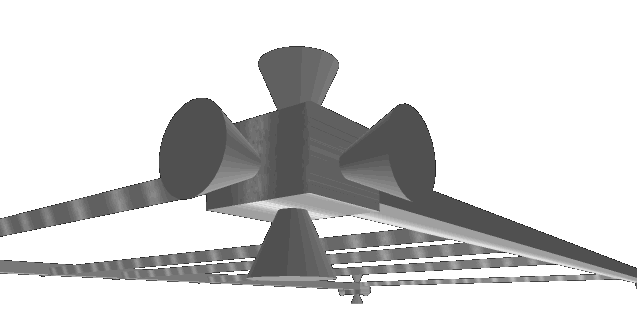
To assist with the stabilization of the platform and reduce the amount of fuel expended, a gyroscopic stabilization system was designed into the center. The useful property of the gyroscope is that when a disk (or ring in this case) is spun at high velocities, the rotation momentum of the disk in the axis of rotation resists movement in a certain plane.
To effectively implement this system in space a gyroscope must be built in all three axis of rotation. When these are being put into motion the thrusters will have to be fired to counteract the torque caused by the change in rotational momentum(Newtons third Law - For every action there is an equal and opposite reaction). Once the gyroscopes have been spun up there will be no counteracting forces necessary. In order to be effective, each gyroscopic component should be in the axis of the center of mass (in the axis of rotation)
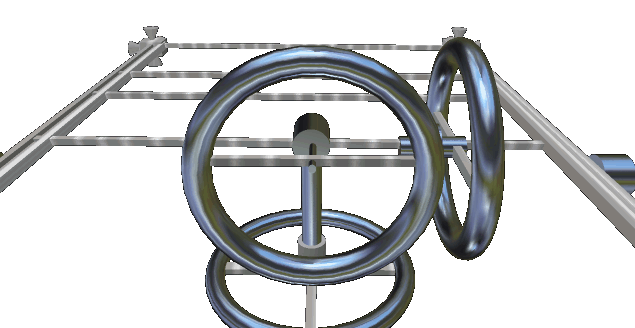
Space provides a very plentiful source of energy from the sun. The primary energy collection will be provided from two solar arrays placed on the sides of the platform. These solar arrays will be able to rotate to track the sun with the aid of computer controlled motors. The dimensions of the solar arrays are approximately 8 x 31.75 m each and each produce 128kW of power.
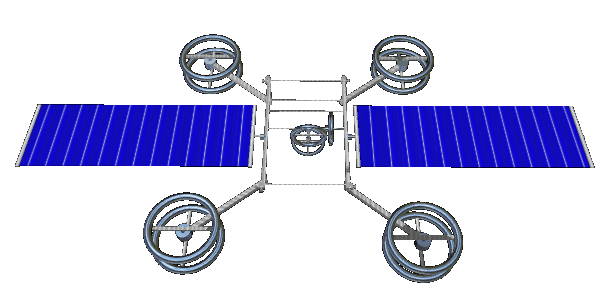
The revolution of the station about the earth means the station will have equal amounts of time in the sun as it will in the dark. To efficiently run the station constant power will need to be supplied. There are several options to store this energy:
Battery storage would not supply sufficient energy. The lead acid battery, which is the commonly used in the car is also much too heavy for the amount of energy storable. Fuel cells have been used by the United States space program for many missions into space however, they require constant supply to stay maintained. The rotational energy storage would be the most efficient system to use in orbit. Each system would involve two counter-rotating rings that would be spun by a motor during the energy collecting portion of the orbit. When in the dark side of the orbit the rotational motion from the flywheels will run the motor as a generator to supply power for the station.
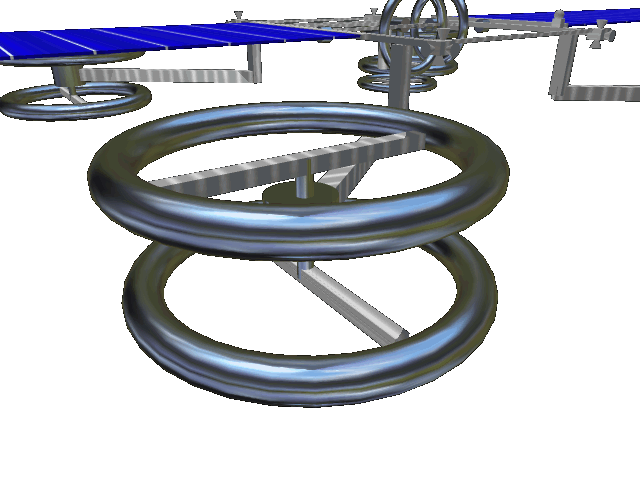
To reduce the frictional forces that could reduce the efficiency of the system, the motors and axles will be equipped with magnetic bearings. Then, when the station passes into the dark side of the earth, the motor would be used as a generator and would use the rotational energy of the rings to generate power. A diagram of the energy system is below.

Since most of the machinery runs on alternating current the power grid will be based on AC. If a particular piece of equipment requires DC, it will have it's own power supply built in. (AC to DC is very efficient compared to DC to AC). To some element of fail-safing, the station is designed with 4 power storage systems - one on every corner of the platform. In the event of a break down, the manufacturing process may be slowed, but key processes like life support and attitude control will be maintained.
 The Canadarm
The Canadarm
In order to allow easier construction, repairs, and movement of supplies a Canada arm was implemented in the design of the space station. The Canada arm would be on a rail on one side of the platform and has a reach that is great enough to reach the other side of the platform. The arm would be manually controllable from the control portion of the human facilities as well as the utility compartment(which will be discussed next).
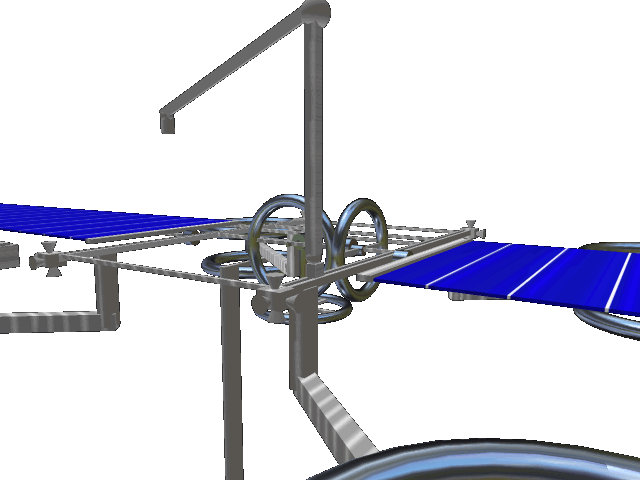
The platform would occasionally need to be visited by humans in order to maintain the equipment, make adjustments in the systems, and to load and unload supplies. To facilitate this, a pressurized utility compartment was designed on the end of the platform which would hold tools and diagnostic equipment for maintenance as well as control systems for the Canadarm. Also included in the compartment are the testing equipment for determining the integrity of the semiconductor chips being produced. To move the neccessary supplies and equipment off the space shuttle and onto the station, a docking port, similar to the one present on the Mir space station, is attached to the utility compartment. The opposite end of the compartment has a modular docking port allowing for three other modules to be connected.
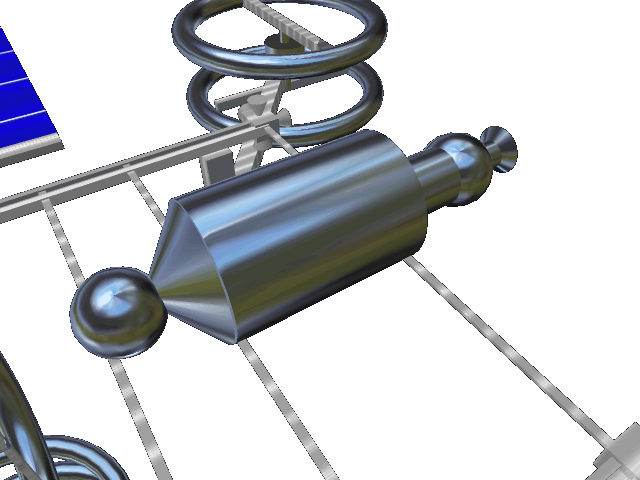
The EVA (Extra Vehicle Activities) Airlock is attached to a one of the modular docking ports on the utility compartment. This allows the crew to exit the compartment and repair equipment as well as to bring the semiconductors produced into the compartment for testing. The airlock would also be big enough to allow machinery to be brought into the airlock for repair in a pressurized situation. The door to the EVA was designed "upwards" so the Canadarm could more easily load equipment in and out.
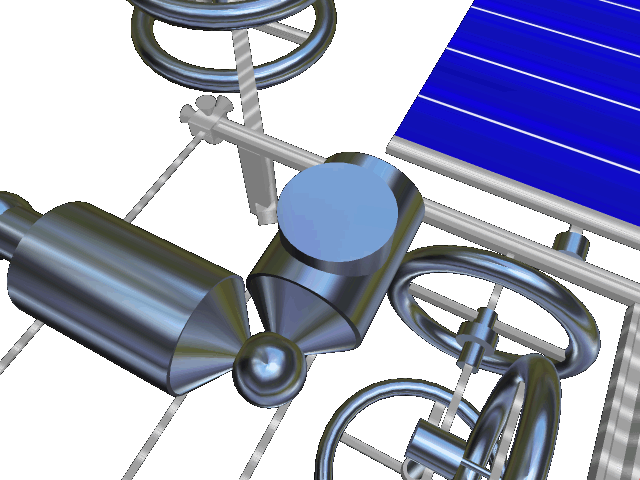
Each component on the station that is neccessary to be moved regularly (or even periodically) is fitted with a standardized mechanical interface. The release mechanism of the interface can be automatically released by robotics (in the case of silicon wafer transport) or manually by a human possibly repairing equipment on the platform. The interface will automatically lock when placed back into the opposing adapter of the interface. With this installed around the facility, removal and replacement of machinery becomes easier and more efficient (because this can be done with the Canadarm). The handling of the silicon wafers becomes more efficient because one robot with multiple interfaces installed can handle many containers of wafers at one time. This also makes for easy storage, and loading and unloading of supplies from the space shuttle.
Immediately next to the utility compartment is a bank of standard interfaces. This is the primary loading and unloading area of the station ("the shipyard") and would allow the Canadarm from the shuttle to be able to quickly move the supplies stored in the bay to the platform without manual mooring of each piece. This is also used for storing the finished products until the shuttle returns.
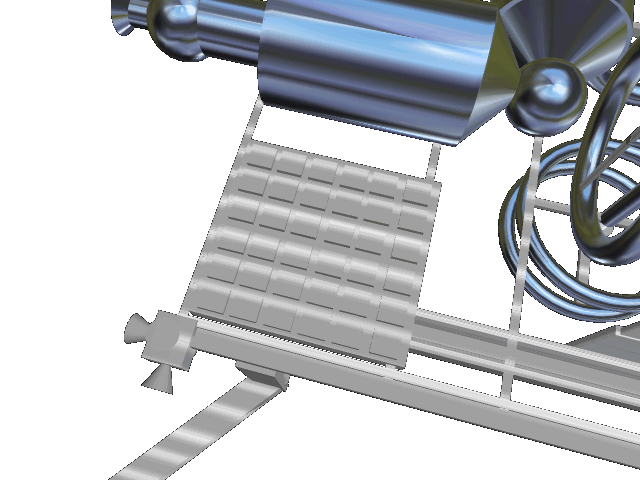
To operate the manufacturing facility efficiently and automatically in the vacuum of space a system of robotics is present on the platform. These robots perform the task of moving the containers of silicon wafers from process to process. The robots move on railing installed on the platform.
The primary robot system is a large robot that is given the task of moving the containers to and from the "shipyard" to the manufacturing line as well as moving each container from machine to machine. This primary robot has a large anthropromorphic arm installed next to a table with a bank of the standardized mechanical interfaces so it can handle multiple containers. Below: the primary robot manipulates a container with the standardized mechanical interface. The tracks which it runs on are visible in the background.

In order for the human controllers of the facility to be able to monitor the progress of the manufacturing without being on the platform complex monitoring systems must be installed. For direct monitoring video cameras are mounted on every corner of the facility. The Canadarm is controlled entirely by humans which requires many video cameras on every major joint and arm segment. Each robot will also have similar camera systems set up in case manual control is neccessary. Every system on the manufacturing platform is monitored by a computer in the line of machinery. This computer analyzes input from each of the machines and gives the feedback to the human users. In the event of a problem the computer will alert the human controllers and will then be able to run diagnostic routines to determine the exact location of the problem. Most systems on the facility will be run semi-autonomously. The humans begin and start each process but do no manual control in the processes.
To the Manufacturing Machinery Page...


